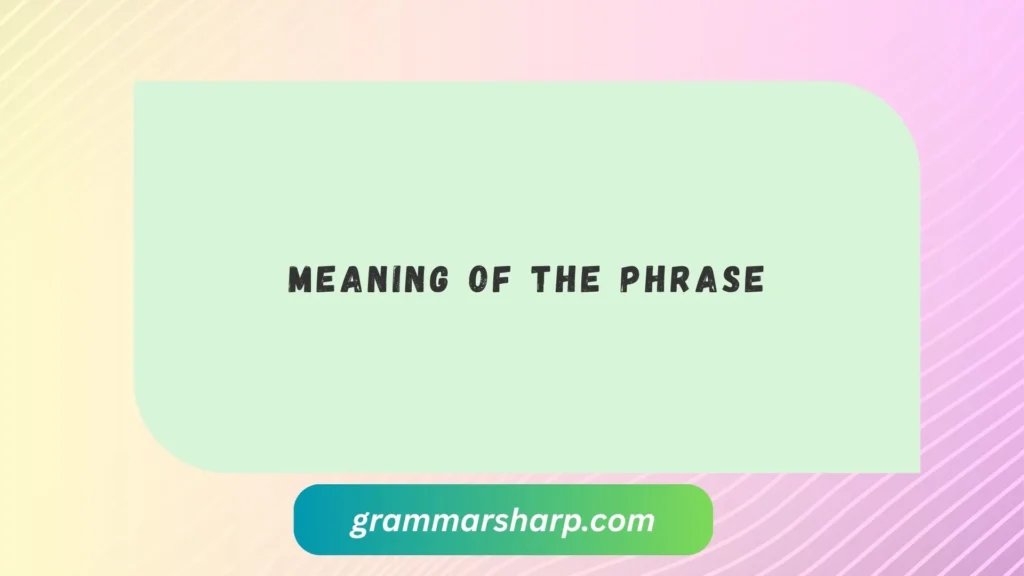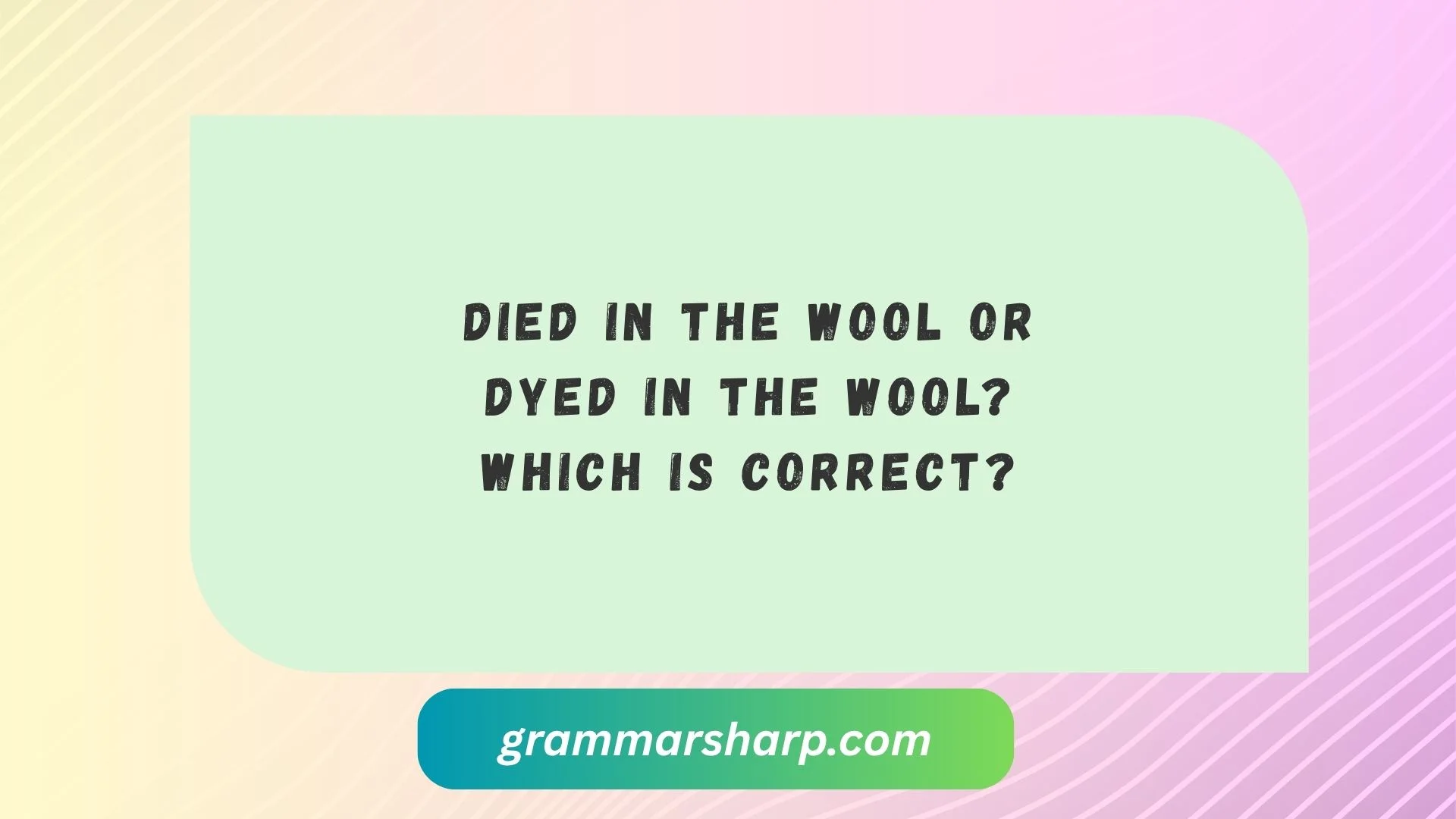If you’ve ever read a sentence and paused, thinking, “Wait, is it died in the wool or dyed in the wool?”, you’re not alone. This classic phrase has confused writers and speakers for generations. It’s one of those idioms that sounds familiar but is often misused. Understanding the correct form is not just about grammar—it’s about using English like a pro and avoiding embarrassing mistakes in writing or conversation.
In this article, we’ll uncover the true meaning of “dyed in the wool”, trace its historical origins, explain why people often get it wrong, and give you tips to use it confidently. You’ll also find examples, comparisons, and even a handy reference table. By the end, you’ll never mistake this phrase again.
Whether you’re writing an essay, crafting professional content, or just curious about quirky English idioms, this guide has everything you need.
Meaning of the Phrase

The phrase “dyed in the wool” is an idiomatic expression that describes someone whose beliefs, habits, or characteristics are deeply ingrained. It suggests that the trait is permanent, almost impossible to change—much like wool that has been dyed thoroughly so that the color penetrates every fiber.
People often mistakenly say “died in the wool”. This is an understandable mistake because “died” sounds the same as “dyed,” but it completely changes the meaning. If you write “died in the wool,” it makes no sense—wool doesn’t die!
Here’s a quick comparison for clarity:
| Phrase | Meaning | Correct Usage? | Example Sentence |
| Dyed in the wool | Deeply ingrained habit or belief | ✅ Correct | “He’s a dyed-in-the-wool environmentalist.” |
| Died in the wool | None (incorrect) | ❌ Incorrect | “She’s a died-in-the-wool optimist.” |
Origins and History

Understanding the history helps explain why the phrase is “dyed” and not “died.”
In medieval times, wool was a primary textile in Europe. Dyeing wool was a labor-intensive process that required immersing raw wool in colored dyes until the color thoroughly penetrated the fibers. Wool that was “dyed in the wool” held its color permanently—it wouldn’t fade or wash out. This literal meaning eventually transformed into a metaphor for permanent or unchangeable traits.
The earliest known figurative use of the phrase appeared in the 18th century in English literature. Writers used it to describe someone with a steadfast character or belief system. Over time, the idiom became widely recognized in both British and American English.
The phonetic similarity between “dyed” and “died” caused the misinterpretation. People hear the phrase, don’t know its textile origins, and naturally assume it refers to death.
Correct Usage
The correct idiom is “dyed in the wool”. It can describe people, ideas, habits, or even political affiliations that are strongly fixed.
Examples in Sentences
- Politics: “He’s a dyed-in-the-wool conservative, unlikely to change his opinions.”
- Personality: “She’s a dyed-in-the-wool optimist who sees the good in everyone.”
- Passion or hobby: “He’s a dyed-in-the-wool fan of jazz music, attending every concert he can.”
Tips for Using the Phrase
- Always pair it with a noun describing the trait or characteristic.
- Use it to emphasize permanence or strong commitment.
- Avoid using it to describe temporary habits or moods.
Incorrect Usage
The most common mistake is writing “died in the wool.” It might sound quirky or even poetic, but it’s wrong. The phrase doesn’t reference death—it references dyeing wool.
Common Mistakes
- “He’s a died-in-the-wool fan of classical music.” ❌
- “She’s a died-in-the-wool pessimist.” ❌
How to Avoid Mistakes
- Remember the origin: wool is dyed, not dead.
- A mnemonic: “Dye your wool, don’t let it die!”
- Think of the phrase in its figurative sense: permanent traits, not mortality.
Related Expressions
Several idioms convey a similar sense of permanence or deep-rooted traits. Using them can enrich your writing:
- Born and bred – deeply influenced by upbringing.
- Hardwired – innate or natural to someone.
- Through and through – completely, in every way.
- Set in stone – unchangeable.
These expressions help convey strong characteristics, just like dyed in the wool.
Read More:Was There or Were There? Understanding the Difference
Fun Facts & Trivia
- The phrase has appeared in works by writers like Jane Austen and Charles Dickens, emphasizing steadfast characters.
- In modern politics, journalists often describe party loyalists as dyed-in-the-wool supporters.
- The idiom is rarely used to describe objects, but occasionally appears metaphorically: “dyed-in-the-wool traditions” in a culture.
- People often create clever puns by accidentally using “died in the wool” in cartoons or memes.
Quick Reference Table
| Phrase | Meaning | Correct Usage? | Example Sentence |
| Dyed in the wool | Deeply ingrained habit or belief | ✅ Correct | “He’s a dyed-in-the-wool environmentalist.” |
| Died in the wool | None (incorrect) | ❌ Incorrect | “She’s a died-in-the-wool optimist.” |
FAQs
Is “dyed in the wool” still used today?
Yes. It’s still common in literature, journalism, and everyday English to describe firm beliefs or characteristics.
Can “died in the wool” ever be correct?
No. It’s a mistaken form based on phonetic confusion. Always use dyed in the wool.
What’s the difference between “dyed in the wool” and “through and through”?
Both suggest permanence, but through and through is more general, while dyed in the wool often applies to traits, beliefs, or loyalties.
How do I remember which is correct?
Think of wool in textiles: you dye it, not let it die.
Can it describe habits?
Yes. Example: “He’s a dyed-in-the-wool morning person.”
Is it formal or casual?
It works in both, though it often appears in formal writing or literature.
Are there regional differences?
No significant difference. Both American and British English use dyed in the wool.
Is it ever hyphenated?
Yes, often written as dyed-in-the-wool when used as an adjective.
Can it be used in business or politics?
Absolutely. Example: “She’s a dyed-in-the-wool strategist, sticking to her long-term plan.”
Why do people confuse it with “died in the wool”?
Because the words sound identical, but the meaning is entirely different.
Conclusion
The correct phrase is undoubtedly “dyed in the wool”. It reflects something permanent, ingrained, and unwavering—just like wool that holds its color after dyeing. Misusing it as “died in the wool” not only looks wrong, it changes the meaning entirely.
Next time you want to describe someone’s steadfast character, political loyalty, or unchanging habits, remember the textile origins. Wool is dyed, and so is the idiom.
By understanding the history, usage, and common mistakes, you’ll never confuse this phrase again. Use it confidently in your writing, and you’ll impress readers with your precision and attention to language.

